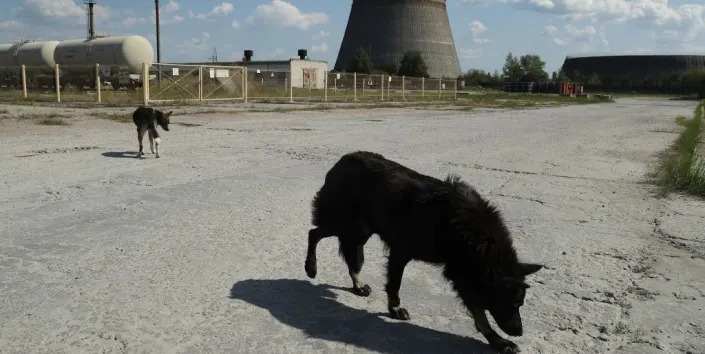1.3k
Darren Orf
Sat, April 1, 2023

Are Chernobyl Dogs Experiencing Rapid Evolution?Sean Gallup - Getty Images
For decades, scientists have studied animals living in or near the Chernobyl Nuclear Power Plant to see how increased levels of radiation affect their health, growth, and evolution.
A new study analyzed the DNA of 302 feral dogs living near the power plant, compared the animals to others living 10 miles away, and found remarkable differences.
While the study doesn’t prove that radiation is the cause of these differences, the data provides an important first step in analyzing these irradiated populations, and understanding how they compare to dogs living elsewhere.
On April 26, 1986, the Chernobyl Nuclear Reactor in northern Ukraine—then part of the Soviet Union—exploded, sending a massive plume of radiation into the sky. Nearly four decades later, the Chernobyl Power Plant and many parts of the surrounding area remain uninhabited—by humans, at least.
Animals of all kinds have thrived in humanity’s absence. Living among radiation-resistant fauna are thousands of feral dogs, many of whom are descendants of pets left behind in the speedy evacuation of the area so many years ago. As the world’s greatest nuclear disaster approaches its 40th anniversary, biologists are now taking a closer look at the animals located inside the Chernobyl Exclusion Zone (CEZ), which is about the size of Yosemite National Park, and investigating how decades of radiation exposure may have altered animals’ genomes—and even, possibly, sped up evolution.
Scientists from the University of South Carolina and the National Human Genome Research Institute have begun examining the DNA of 302 feral dogs found in or around the CEZ to better understand how radiation may have altered their genomes. Their results were published in the journal Science Advances earlier this month.
“Do they have mutations that they’ve acquired that allow them to live and breed successfully in this region?” co-author Elaine Ostrander, a dog genomics expert at the National Human Genome Research Institute, told The New York Times. “What challenges do they face and how have they coped genetically?”
The idea of radiation speeding up natural evolution isn’t a new one. The practice of purposefully irradiating seeds in outer space to induce advantageous mutations, for example, is now a well-worn method for developing crops well-suited for a warming world.
Scientists have been analyzing certain animals living within the CEZ for years, including bacteria, rodents, and even birds. One study back in 2016 found that Eastern tree frogs (Hyla orientalis), which are usually a green color, were more commonly black within the CEZ. The biologists theorize that the frogs experienced a beneficial mutation in melanin—pigments responsible for skin color—that helped ionize the surrounding radiation.
This made scientists ponder: could something similar be happening to Chernobyl’s wild dogs?
This new study uncovered that the feral dogs living near the Chernobyl Power Plant showed distinct genetic differences from dogs living only some 10 miles away in nearby Chernobyl City. While this may seem to heavily imply that these dogs have undergone some type of rapid mutation or evolution due to radiation exposure, this study is only a first step in proving that hypothesis. One environmental scientist, speaking with Science News, says that these studies can be tricky business, largely due to the fact that sussing out radiation-induced mutations from other effects, like inbreeding, is incredibly difficult.
However, this study provides a template for further investigation into the effects of radiation on larger mammals, as the DNA of dogs roaming the Chernobyl Power Plant and nearby Chernobyl City can be compared to dogs living in non-irradiated areas. Despite a current lack of firm conclusions, the study has shown once again that an area that—by all rights—should be a wasteland has become an unparalleled scientific opportunity to understand radiation and its impact on natural evolution.
No comments:
Post a Comment